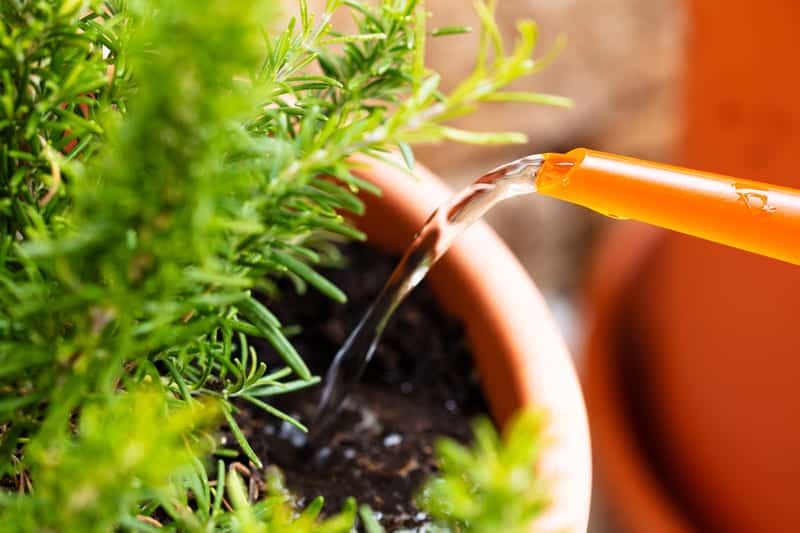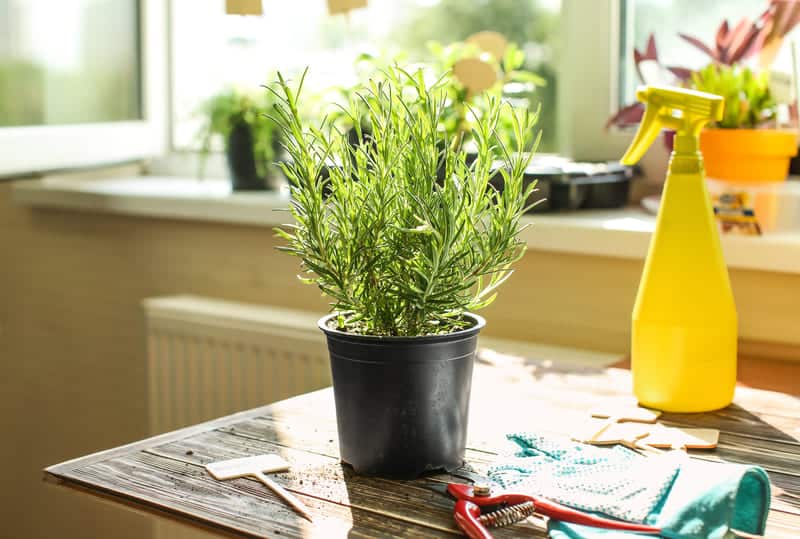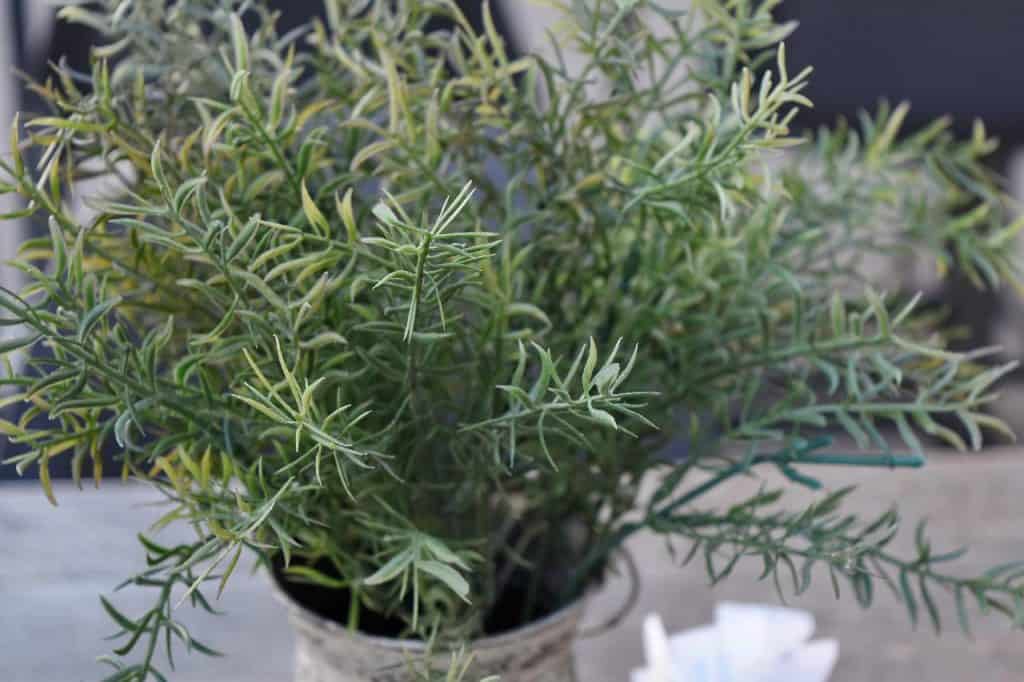Rosemary (Rosmarinus officinalis) is an evergreen shrub with gray-green, coniferous leaves native to Persia that grows wild in the Mediterranean climate and can grow 3 to 4 feet in height and equal in width.
In its natural habitat, the plant blooms in March and April and later in September, with tiny purple-white flowers gathered in clustered inflorescences at the top of the branches.
As medicine and spice, the plant has been used since ancient times, and today it’s an indispensable ingredient of Mediterranean cuisine.
In the USA climate zone 9 and more, it can overwinter outdoors in the garden, while in other areas with a harsher climate, it is usually grown as a potted plant.
Below is a guide on how to care for rosemary properly, so take a look.
How to Care for Rosemary?
Care for rosemary, including proper watering of the plant, depends on the overall conditions in which it grows.
Caring for a potted plant and a garden plant always differ due to the limited resources that potted plants have at their disposal. On the other hand, potted plants spend the winter in a protected and warm environment at room temperature.
We treat them differently from those plants that remain outside during the winter, exposed to low temperatures and precipitation.
Watering Rosemary in the Garden
Although rosemary is a plant from a warm climate, it tolerates low temperatures well. As a garden plant, it can grow in areas outside climate zone eight if you protect it from cold wind and excessive soil moisture.
The lowest temperature it can withstand without damage is 5 F which allows the cultivation of this plant in continental areas.
Choose a place with the most sun in the garden and, if possible, plant it along the south faces walls. The wall will heat the plant and protect it from the wind. It grows best in soil well-drained ground.
Therefore, avoid compacted clay soils that retain moisture for a long time. If you want to improve soil permeability, mix sand into the garden soil before planting rosemary.
The first two weeks after planting rosemary water it every other day to take root as well as possible. Accustomed to the dry Mediterranean air and low annual rain, later you can water the rosemary in the garden only if the summer is extremely dry.
Otherwise, natural precipitation is enough to meet its water needs. Namely, rosemary has a strong and deep root and can draw moisture from deeper soil layers.
Regardless it grows in the ground or the pot, rosemary is much harder to deal with excess than with a lack of water. However, if it’s not watered for a long time or has not rained for weeks, this durable plant will show signs of dehydration.
Signs of Dehydration in Rosemary
Its tiny leaves begin to dry and change color, so instead of a dark green face and a silvery hairy back, the leaf has a brownish color, and it is dry and brittle to the touch.
Water the plant immediately if you notice a change like this. The deformations suggest that there is no more water or moisture in the soil that the root can absorb, which ultimately leads to the complete decay of the plant.
In autumn, protect the root of the plant with a thick layer of mulch.
Frost and low temperatures can damage its aboveground part during the winter. Frozen leaves you often cannot notice before spring comes because they will not change color until a new vegetative cycle begins.
Only when it warms, the leaves will turn brown and fall off.
Therefore, in the spring, you can prune your rosemary by removing all damaged parts. This measure is doubly beneficial: the plant will look much better and develop a bush in a lush canopy if you shorten it every spring.
Rosemary Indoors
The best part of growing rosemary indoors is that you can smell it in the air every time you pass by it!
In addition to having your favorite spice at your fingertips, the scent of rosemary is believed to reduce stress and anxiety, which is an additional reason to grow this precious plant at home.
However, for its successful cultivation indoors, pay attention to the following:
Pot Selection
Rosemary is a plant that grows in the open and has a strong root, so you need to provide enough space for it to grow, so make sure the pot is large enough.
Usually, when we buy ready-made rosemary seedlings, they’re in a small container with a diameter of 5 to 7 inches. For starters, this is enough, but as the plant develops, it needs a larger pot. That is why it is best to move the seedling you bought in the spring to a 10-inch-diameter planter as soon as you get it.
Such a pot will provide enough space for root growth during the season, and proper root growth directly affects the growth and development of the leafy part of the plant.
In addition to size, pay attention to the material from which the pot is made. Terracotta and clay are natural materials, which means that they can absorb excess moisture from the substrate.
Therefore, the rosemary planted in such a pot is more likely to avoid excessive moisture and potential root rot. And, of course, the container must have drainage openings through which excess water will flow when watering.
Collecting water in the bottom of the pot is a recipe for disaster!
Substrate
Plant your rosemary into a loose and well-draining substrate.
You can use the ready-made soil for Mediterranean plants or make your mixture by combining the all-purpose soil and sand in an equal ratio.
Position
Rosemary requires sun, so it’s best to place it near windows facing west or south, and it needs about 6 hours of direct sunlight.
If you don’t have a window that could provide your plant with adequate light, you can place a lamp above the top of the plant and thus provide it with enough light.
The best room is one that heats up a bit during the winter; hot air from a stove or radiator can destroy the plant. And don’t worry if the room is not warm, as we said, it tolerates low temperatures well!
Watering
How often you water the rosemary in the pot primarily depends on the position in which it grows and the seasons.
Water from the soil evaporates faster if the plant is located on a sunny west window, so you need to water such a plant more often than the one that grows on the east window and which is exposed to direct light only in the morning.
Roughly, you can water the rosemary twice a week, in the growing season, but make sure that the rhythm of watering corresponds to all other cultivating factors.
Therefore the best way to check if the plant needs water is to push the finger at depth of two inches into a container with the substrate. If it’s dry, give the plant a new portion of water.
Rosemary doesn’t like too much moisture, so avoid constant soaking of the substrate.
In winter, the day is shortened and the evaporation of water from the soil takes longer. Furthermore, due to space heating the plant is often exposed to harmful dry air.
Therefore, the watering regime from autumn to spring must adapt to winter conditions. In this period, water the plant less frequently, about once a week if you keep it in a heated room.
In a room with very dry air, occasionally spray the leaves with lukewarm stagnant water. It’s a period of dormancy in which the plant will stop the vegetative phase, so don’t be surprised if it does not give new leaves.
Water your rosemary once in ten days if you keep the plant in an unheated space such as a walkway or hallway in winter.
The combination of low temperatures and soil moisture is detrimental to potted rosemary.



